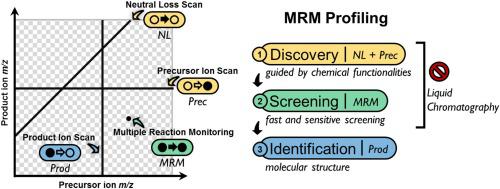Chemistry and Physics of Lipids ( IF 3.4 ) Pub Date : 2021-02-06 , DOI: 10.1016/j.chemphyslip.2021.105048 Zhuoer Xie 1 , Christina R Ferreira 2 , Alessandra A Virequ 3 , R Graham Cooks 1

|
Small molecules, including metabolites and lipids, provide information on metabolic pathways and active biological processes in living organisms. They are often diagnostic of disease. Current exploratory methods for metabolomics and lipidomics mostly rely on separation using liquid or gas chromatography (LC or GC) coupled with mass spectrometers capable of acquiring high resolution data to generate an enormous data, but at the cost of lengthy processing and data acquisition. Even though many molecules can be identified and quantified by these methods, the laborious protocols for purification, identification, and validation limit the accessible sample chemical information. To improve the speed and efficiency of exploratory metabolomics and lipidomics, multiple reaction monitoring profiling (MRM profiling) has been developed. This strategy involves a three-stage workflow which starts by considering the metabolome as a collection of functional groups. The Discovery Stage interrogates a representative sample mixture for functional groups using the functional group specific precursor ion (Prec) scans and neutral loss (NL) scans. This experiment usually uses a triple quadrupole mass spectrometer without chromatography, i.e. by direct sample infusion. In the second Screening Stage, the main features seen in the Prec and NL scans are organized into lists of precursor ion/product ion transitions (MRMs) which are then used for the fast, specific, and sensitive interrogation of each individual sample. Data analysis by univariate and multivariate statistical methods is used to identify the most informative MRMs and so classify the individual samples. The compounds (biomarkers) which are responsible for the most informative MRMs in particular sample classes can be investigated in an optional third Identification Stage i.e. in a structural identification study. MRM profiling benefits from the much smaller number of functional groups compared to the number of individual metabolites existing in biological samples (where most metabolites are still unknown), resulting in acquisition of a much smaller data set and a shorter analysis time. The application of MRM Profiling to several biological and clinical problems is used to illustrate its features.
中文翻译:

多反应监测分析(MRM 分析):以化学功能为指导的小分子探索性分析
小分子,包括代谢物和脂质,提供有关生物体中代谢途径和活性生物过程的信息。它们通常用于诊断疾病。目前代谢组学和脂质组学的探索性方法主要依赖于使用液相色谱或气相色谱(LC 或 GC)与能够获取高分辨率数据以生成大量数据的质谱仪相结合的分离,但以冗长的处理和数据获取为代价。尽管可以通过这些方法识别和量化许多分子,但用于纯化、识别和验证的繁琐协议限制了可获取的样品化学信息。为了提高探索性代谢组学和脂质组学的速度和效率,已开发出多反应监测分析(MRM 分析)。该策略涉及一个三阶段工作流程,首先将代谢组视为功能组的集合。Discovery Stage 使用官能团特定的母离子 (Prec) 扫描和中性丢失 (NL) 扫描来查询具有代表性的样品混合物的官能团。该实验通常使用没有色谱的三重四极杆质谱仪,即通过直接样品注入。在第二个筛选阶段,Prec 和 NL 扫描中看到的主要特征被组织成母离子/子离子转换 (MRM) 列表,然后用于对每个单独样品进行快速、特异性和灵敏的询问。通过单变量和多变量统计方法进行的数据分析用于识别信息量最大的 MRM,从而对单个样本进行分类。可以在可选的第三个鉴定阶段(即结构鉴定研究)中研究在特定样品类别中产生最多信息的 MRM 的化合物(生物标志物)。与生物样品中存在的个体代谢物的数量(其中大多数代谢物仍然未知)相比,MRM 分析受益于更少的官能团数量,从而导致获得更小的数据集和更短的分析时间。MRM Profiling 在几个生物学和临床问题中的应用被用来说明它的特点。与生物样品中存在的个体代谢物的数量(其中大多数代谢物仍然未知)相比,MRM 分析受益于更少的官能团数量,从而导致获得更小的数据集和更短的分析时间。MRM Profiling 在几个生物学和临床问题中的应用被用来说明它的特点。与生物样品中存在的个体代谢物的数量(其中大多数代谢物仍然未知)相比,MRM 分析受益于更少的官能团数量,从而导致获得更小的数据集和更短的分析时间。MRM Profiling 在几个生物学和临床问题中的应用被用来说明它的特点。


























 京公网安备 11010802027423号
京公网安备 11010802027423号